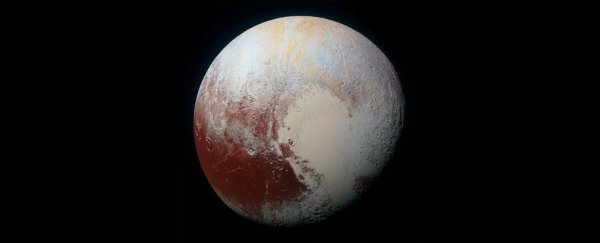When the New Horizons spacecraft arrived at Pluto in 2015, the probe revealed the dwarf planet's true nature: Pluto is a frozen lump, sure, but it is an odd and interesting lump.
Pluto has a heart-shaped icecap that, in theory, could hide an ocean. For no obvious reason, Pluto spits out X-rays. And when New Horizons took Pluto's temperature, the dwarf planet was cold - colder, even, than anyone had predicted. Researchers were puzzled.
Earthbound instruments gauged Pluto to be minus 280 degrees Fahrenheit (-173 Celsius). New Horizons showed that Pluto's thermostat was dialled to 330 degrees below Fahrenheit (-201 Celsius).
Pluto makes the coldest spot on Earth seem downright balmy: In 2013, researchers announced that a NASA satellite observed a record Antarctic chill at minus 135.8 (-93.2 degrees Celsius), a temperature humans could survive for just three minutes.
You would expect Pluto to be chilly. The dwarf planet drifts through the Solar System's back roads at an average distance of 3.67 billion miles (5.9 billion kilometres) from the Sun. Earth is 40 times as close to our star. Pluto is small, which means its gravity is weak.
Lacking a firm grip, its atmosphere leaks into space. In fact, the thinness of Pluto's atmosphere made estimating its temperature from Earth very difficult, said Xi Zhang, a planetary scientist at the University of California at Santa Cruz.
Pluto is not so far away that the chemicals in its atmosphere are immune to sunlight. Researchers hypothesise that the sun's ultraviolet rays break down nitrogen, methane and other gases in Pluto's atmosphere, creating a haze of solid particles.
"New Horizons' images basically showed a lot of haze particles," Zhang said.
Zhang and his colleagues, in a report published in the journal Nature this week, argue that Pluto's hazy coat explains why the dwarf planet is extra-chilly.
Pluto's haze is so abundant that it can absorb a lot of solar radiation, Zhang said, though there's a good deal of uncertainty about this complex atmospheric chemistry.
"We really don't know the detailed composition of the haze particles," he said.
What is known is that the smog begins to form high in Pluto's atmosphere, several hundred miles up. Gases condense on the particles.
The particles fall downward and chain together, like a formation of skydivers - except the chemical clusters won't break away before landing.
New Horizons detected a thick layer of these hydrocarbon particles, called tholins, that paint Pluto's surface red.
Crucially, the haze particles are much larger than gas molecules, which means that the haze's ability to heat up and cool down is greater.
Modeling the heat transfer through Pluto's atmosphere, Zhang and his colleagues found that the net effect is cooling; the haze absorbs solar energy and radiates it into space, a bit like sweat that wicks away body heat.
Previous hypotheses suggested that gaseous hydrogen cyanide was the coolant.
Recent probes of Pluto, however, found too little of the gas, Zhang said. Water vapor could also be chilling Pluto, but Zhang said the sheer amount of vapor that would be needed made this a dubious prospect.
In an accompanying commentary in Nature, Robert West, an expert in planetary atmospheres at Caltech's Jet Propulsion Laboratory, described this conclusion as "remarkable".
But West also wrote that "the case is not yet closed on our understanding of Pluto's atmospheric temperature."
The study authors' model indicates that Pluto's smog radiates heat into space in the infrared spectrum - a feature that New Horizons was not equipped to observe.
Researchers may have their answer within two years. The James Webb Telescope, the observatory slated to be launched into space in 2019, will have the right instruments.
"That may be the best telescope we have ever built," Zhang said.
Once aimed at Pluto, the Webb telescope will show whether the dwarf planet indeed sweats in infrared.
2017 © The Washington Post
This article was originally published by The Washington Post.
